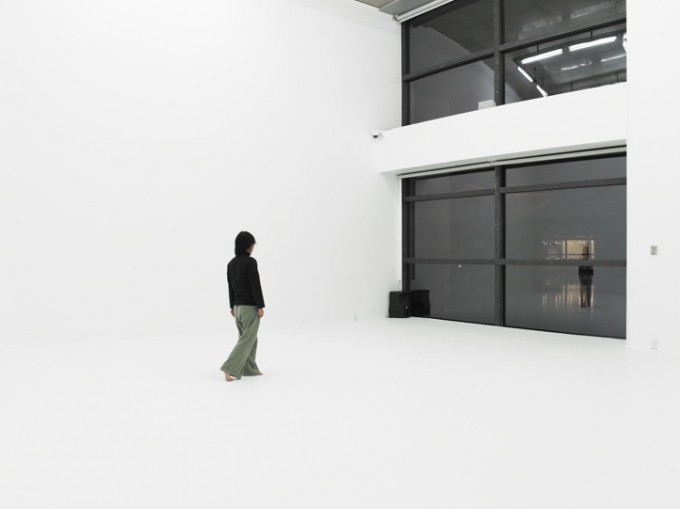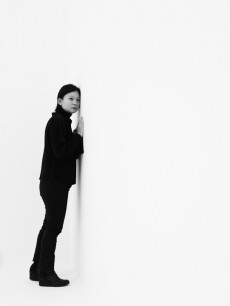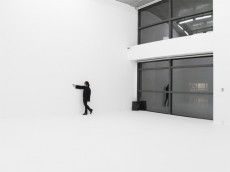
吃驚 BIKKURI
2010年10月23日(土)~11月21日(日)
アンジー・アトマジャヤ
Angie ATMADJAJA

《424.42m3 56.7Hz TILT》 撮影:山本糾
身体全体で知覚する音響彫刻
服部 浩之
“音を純粋に身体全体で体感できる作品をつくりたい”という独自の音楽的思考が、アンジー・アトマジャヤの創作活動の基底にはある。
アトマジャヤは幼少よりピアニストになるべく音楽教育を受け、その後専攻を作曲に転向し器楽曲や電子音響による作曲を学んだ。さらに音響空間や音響現象に興味をもち、ヨーク大学にて科学技術と芸術を結節するサウンドアートを学んだ。それと並行してサウンドエンジニア/作曲家としてダンスや舞台の仕事も経験する。このダンサーや振付家との恊働により、彼らが耳だけでなく身体全体で音を知覚するということを知り、より身体的・総合的経験としての音響空間への興味を拡大していった。このように彼女のサウンドアーティストとしてのキャリアはスタンダードな音楽教育を基礎に、他ジャンルとの恊働などを経て、アート&テクノロジーを基調とする体感的で相互作用のある音空間をつくるという現在の表現に至っているのだ。
今回アトマジャヤは、作品を発表するギャラリーBの空間の特性を周到に把握するところから制作にとりかかった。空間を極めて客観的に観察し、音響という地平からどんな応答ができるか、論理的に場との対話を重ね音響空間をつくり出していくのだ。ACACの設計者である安藤忠雄の建築に対する考え方やこれまでの建築作品を調査し、「見えない建築」という安藤によるACACのコンセプトを熟慮し理解したうえで、それに対する返歌の如くサウンドインスタレーションを実践した。
アトマジャヤがつくりだした作品は、まさしく「見えない作品」なのだ。ギャラリーBには一見するだけではほとんど視覚的に明確なオブジェはなにも見出せず、目に痛いくらい真っ白な空間だけが広がり、身体に直接響く重低音の単音が充満しているのを感じるのみだ。(fig.1) 目に見えるものといえば、通常のコンクリートの床の上に敷かれた真っ白な床面、池に面するガラス面左手の壁手前に設置された一台のスピーカー、壁面の目線の高さにうっすらと描かれた1本のライン、そして風除室のアルコーブに設置された2点の模型くらいだ。(fig.2,3,4) ぱっとみるとそれだけなのだが、しかしながらゆっくりと噛み締めるようにこの空間に没入していくと、驚くほど様々な要素を徐々に知覚していくことができる。
室内で静止していたときには一定の重低音が流れていると感じたのだが、白い床の上を歩き始めると、それに合わせて音の大きさや音色が変化していくのが感じられる。例えば入口から見て室内右手奥のちいさな開口部のあたりにいくと非常に大きな低音が耳だけでなく身体中に響いてくるのだが、少し手前まで移動するとその音は途端に消失して静寂がやってくる。またそこから水のテラスに面するガラスの前を反対側の壁面に向かって移動していくと、音が大きくなったり小さくなったりどんどん変化していく。さらに壁面沿いを少し歩いて部屋の中央に向かっていくと、あるポイントにたどり着いた瞬間に一瞬で全ての音が途絶えたりする。移動により発見できるのは、自身がどこかに静止しているとある一定の音が聞こえるだけ(あるいは何も聞こえない場合もある)なのだが、ひとたび移動するとそれに合わせて音はどんどん変化していくということだ。また、音の高低や大小の変化に合わせるように、床の地形が微妙に変化していくことも徐々に知覚される。音が大きなポイントでは床面が少しだけ高くなるように、そして音の小さくなるポイントは床面が低くなるように、床面はなだらかな凹凸をもっている。壁面にかすかに描かれた1本のラインは、基本的にはほとんど目に見えないが、壁に近づいていくとほのかにラインが現れ、移動すると床の微妙な高低によりこのラインも少しずつ上下に振れて見えたり、また少し離れると消失していったりと、音の変化にシンクロするように視覚的にもその差異をあわく描出している。全てがささやかな変化なのだが、この静寂のなかに意識を埋没すると途端に様々な現象の連鎖が知覚されるのだ。
つまり、アトマジャヤは身体全身と五感で知覚される“音の地形”をこの空間のもつ特性を増幅するようにつくり出したのだ。彼女はまず室内全体に90㎝のグリッドを設定し、104の交点を抽出した。そして様々な周波数の正弦波を流し、全交点の音量や音の振幅をオーディオメーター(聴力計)で計測し、この空間に対してもっとも興味深い変化に富んだ音の地形をつくり出す56.7Hzという周波数を各点の音量から導き出した。音は床、壁、天井で反射し、空気を振動させることにより人間の鼓膜に伝わり認識される。表面が固い素材ほど音をよく反射し、柔らかい素材ほど音を吸収しやすいという特徴がある。つまり空間の大きさ、形態、表面の素材によって音の反射は全く異なり、音量や振幅も計測点によって異なってくる。アトマジャヤはギャラリーBがどのような音響特性を持っているのかを計測し、各ポイントでの音量を視覚化するように音の大小を床の地形にも変換した。そして56.7Hzの正弦波を音源となるスピーカーから出力する。≪442.42? 56.7Hz TILT≫というこの作品のタイトルは、この空間の特性が作品を規定していったということを明快に示している。つまり彼女は総容積442.42?のギャラリーBの空間に56.7Hzの周波数の正弦波を挿入することで、様々な傾斜(tilt)をもつ音の地形をつくりだしたのだ。ひとつの波長の正弦波のみが音源となるスピーカーから出力され、同じ方向の波形がぶつかるポイントでは音は強めあい、逆の波形がぶつかるポイントでは音は弱めあう。室内を反響する正弦波が、ある場所では強め合い音量を倍増し、ある場所では弱め合い音量を減縮するという性質によって音の地形をつくり出したのだ。
以上にようにアトマジャヤの作品は極めてサイトスペシフィックな音響彫刻である。彼女は所与の空間を観察・解釈し、その空間が潜在的に持っている音響特性を引き出すかたちで、鑑賞者の身体と知覚に直接訴えかける音響空間を造形しているのだ。これは場との対話であり、音楽という観点から空間を構築するものである。
また、正しく音楽家らしい側面が彼女の観客との関係の築き方によく見てとれた。展覧会期中彼女は時間があると水のテラスを挟んだ対岸のラウンジからギャラリーBを観察し、作品を体験する観客の反応に注視していた。作品に戸惑う観客がいると声を掛け作品の意図を伝えたり、あるときは鑑賞ツアーのごとく一緒に作品を体験し、またときには観客の意見を聞き、その場で複数の正弦波を出力し全く異なる音響空間を体験してもらったりと、相手に応じて様々な手法で多様な作品体験を提供していた。これはやはり観客ありきのピアニストとしての演奏経験や、ダンスの音楽をつくるなど、よりライブに近い状況で常に観客の反応を意識しながら、その場を成立させるという対話的な音楽活動の経験があるからだろう。やはり彼女は正統な音楽家的DNAに突き動かされながらサウンドインスタレーションを実践していると言えるのではなかろうか。
美術作品では、その文脈やどのような背景でその作品が生まれたのかを知ることによってはじめて理解できるようなものも多々あるが、彼女の作品は前提となる知識や文脈など皆無でも、もっとも原初的な身体経験として純粋に作品を楽しむことができる。もちろんサウンドアートに関する知識を持ったうえで見えてくることが多々あることも事実である。ただどんな人でもその人なりの視点でそれぞれに堪能できる許容力を持った作品であると言ってよいだろう。また所与の状況をよく捉え、音の観点から空間を解析し、それに対して新たな音響構造を対話的に構築していくあたりは建築的でさえある。
いずれにしても、コンテクスト重視の美術作品が多いなかで、静かに集中し全身の感覚を研ぎすまし知覚することにより、身体的経験として作品に触れ、それによって様々に思考を巡らせることは、もういちど現在のアートについて根源的に思索するよい体験となるのではなかろうか。そこでしかできない体験というのは大切にしたいものだ、と再確認させてくれる作品であった。

撮影:山本糾

fig.1 サウンド・インスタレーション全景

fig.2 音量をフロアレベルに変換したコンセプト模型

fig.3 フロアプランの模型

fig.4 壁面に描かれた一本のライン
吃驚 BIKKURI
October 23 -- November 21, 2010.
Angie ATMADJAJA
アンジー・アトマジャヤ

424.42m3 56.7Hz TILT photo: YAMAMOTO Tadasu
Acoustic sculpture physically tangible
HATTORI Hiroyuki
“I want to create works in which viewers can physically and perceptually feel sound with their whole body,” says Angie ATMADJAJA, and such unique orientation around music underlies her creative activities.
Since childhood, Atmadjaja was educated to be a pianist, and later she turned to instrumental and electronic music composition. As she was interested in acoustic space and phenomena, she studied sound art that combines technology and art at the University of York. In parallel with such study, she worked as a sound engineer and composer for dance and stage performances. While collaborating with dancers and choreographers, she came to understand that they perceived sound with not only their ears but also using their whole body. Consequently, she deepened her interest in acoustic space as giving physical and integrated experience. Backed by basic standard education in music and collaboration with people in other genres, she has concentrated on a career as a sound artist, currently expressing sound space that is physically tangible and interactive based on art and technology.
This time, Atmadjaja began to work with thorough understanding of the spatial features of Gallery B where she was to exhibit her work. In order to create an acoustic space, she observed the space objectively and conversed with the place logically to find out how she could respond at the horizon of sound. After having looked into the approach to architecture of architect ANDO Tadao, who designed ACAC, and his architectural works up to date, and thoroughly understood his concept of ACAC, that is “invisible architecture,” she made her sound installation as if it were a poem composed in response to that concept.
The installation made up by Atmadjaja is exactly “an invisible work.” At first glance, there is hardly any explicitly visible object. Only dazzlingly white space spreads, and all you feel throughout your body is a single tone of heavy low-pitched sound filling the space. (fig.1) Speaking of visible things, they are the white surface of an ordinary concrete floor, a speaker installed in the corner of the wall on the left hand side and a pane of glass facing the Water Terrace, a line slightly drawn at eye level on the wall, and two pieces of models placed in the alcove outside the exhibition room. (fig.2, 3, 4) That is all you see at a glance, but when you get yourself immersed in the space as if digesting your feeling slowly, you will gradually perceive remarkably diverse elements.
When I was at rest in the room, I felt that I heard some heavy low-pitched sound, but the moment I began to walk around on the white floor, I felt that the volume and tone of the sound were changing to my movement. For instance, when I approached a small opening at the inner part on the right hand side of the room viewed from the entrance, I heard very loud low-pitched sound reverberating not only in my ears but also throughout my body, but when I moved back towards the entrance, all of a sudden the sound was no longer heard and there was stillness. Moving towards the wall on the opposite side in front of the pane of glass facing the Water Terrace, I heard sound becoming loud and low in turn, constantly changing. Further walking along the wall to the center of the room, I came to a certain spot, and in a second, all the sound fell silent. What I found out while moving around was that when I was standing still somewhere, I heard some sound (or heard no sound at all), but once I began to move, sound changed to my movement. I became gradually aware that the floor surface was subtly uneven as if responding to the pitch and loudness of sound. The floor surface was slightly irregular: delicately elevated at the spot where sound was loud and slightly sunk where sound was quiet. A line that was drawn vaguely on the wall was hardly seen, but as I approached the wall, it became dimly visible and when I moved, it looked gently swinging up and down to conform to the subtle roughness of the floor surface. And at some distance, it disappeared. Such differences in sync with the change of sound were visible and softly expressed. Though they were all small changes, the moment I was wrapped up by this stillness, I began to perceive chain reactions of various phenomena.
In short, Atmadjaja created “sound topography,” which you could perceive throughout your body with five senses, so that the characteristics of this space would be amplified. First, she set up 90cm grids all over the room with 104 intersection points. Transmitting sine waves of varied frequencies, she measured the sound volume and amplitude at each intersection point using an audiometer. Out of this measurement, she concluded that 56.7Hz frequency enabled her to produce sound topography with the most interesting variations for the space. Sound reverberates on the floor, wall and ceiling vibrating air, and reaches our ears for us to perceive. A characteristic found in sound is that it echoes well on materials with the hard surface, while on things with the soft surface, sound is likely to be absorbed. In short, the reverberation of sound differs greatly depending on the size and form of the space as well as the surface of different materials. Also the volume and amplitude vary according to the measuring spot. Atmadjaja measured what sort of acoustic properties the Gallery B had, and converted the volume of sound into the surface of the floor so as to visualize sound at each intersection point. The output came from a speaker with the sound source of 56.7Hz sine waves. The title of the installation, “442.42m3 56.7Hz TILT,” indicates clearly how the characteristics of the space prescribed the work. In other words, by inserting 56.7Hz sine waves into the space of the Gallery B with total capacity of 442.42m3, she created successfully sound topography with varied tilts. With the output from a speaker whose sound source was solely sine waves of one wavelength, sound was strengthened where wave patterns in the similar courses hit each other, while at the spot where those in the reverse courses ran into each other, sound became weakened. Making use of the properties of sine waves that reverberate in the room doubling the loudness by increasing strength at some places and reducing it by decreasing strength at other places, she produced sound topography.
As described above, Atmadjaja’s acoustic sculpture is extremely site-specific. With her observation and interpretation of the given space, she creates an acoustic space that appeals directly to the viewer’s body and perception by bringing out latent acoustic features of the space. It is communication with the place and construction of the space in a perspective of music.
In addition, her character as a genuine musician was revealed in how she built up relations with visitors. During the exhibition period, she watched the Gallery B carefully from a lounge on the opposite side of the Water Terrace when she had time, and observed visitors’ reactions to her work. When she happened to see a visitor puzzled by the work, she spoke to that person to explain her intention. She sometimes experienced the work together with visitors as if in a guided tour, and at other times, she listened to their opinions and made a totally different acoustic space using the output of plural sine waves to have them experience a different space. Thus, she presented different ways of experiencing the work, depending on whom she spoke to. Probably this comes from her experience of playing the piano before the audience, composing dance music and doing interactive activities similar to live performances in which she was always conscious of the audience’s reactions. You might say that after all her DNA of an orthodox musician has stimulated her to create sound installations.
Speaking of artworks, there are many pieces, which we can appreciate only when we understand the context or background of their makings. As for her work, on the other hand, we can purely enjoy it as our primitive bodily experience even when we have no knowledge of her work and context as a premise. It is true, however, that if you had knowledge of sound art, you could see things in the work that would not have been possible otherwise. Nevertheless, the capacity of her work allows everyone to enjoy it in their own way. What is more, her way of understanding the given situation, analyzing the space in view of sound, and constructing a new acoustic structure interactively may be considered architectural.
Today many artworks emphasize contextual meaning, but this installation, which we can experience with our body and calmly concentrate our senses to perceive, provides a good opportunity for us to think about fundamental quality of contemporary art. This work made us recognize anew the importance of our experience, which could be replaced nowhere else.

photo: YAMAMOTO Tadasu

fig.1 Whole view of sound installation.

fig.2 Conceptual model with the sound volume converted to a floor level.

fig.3 Floor-plan model.

fig.4 One line drawn on the wall.
